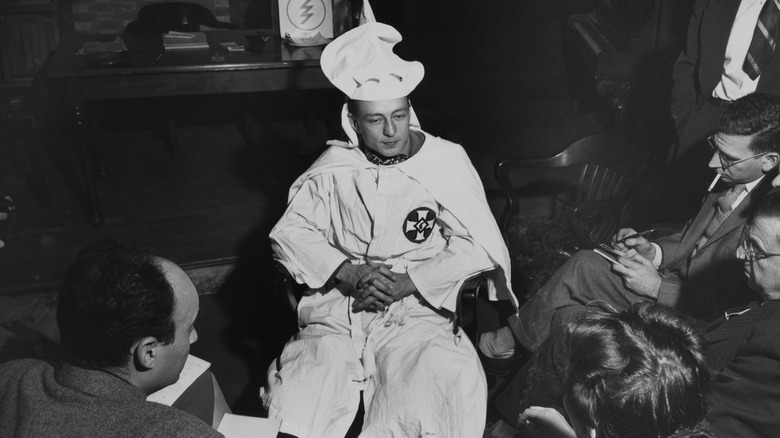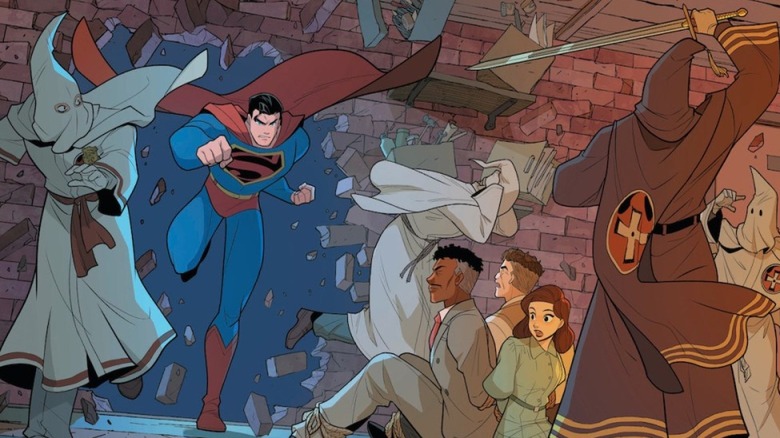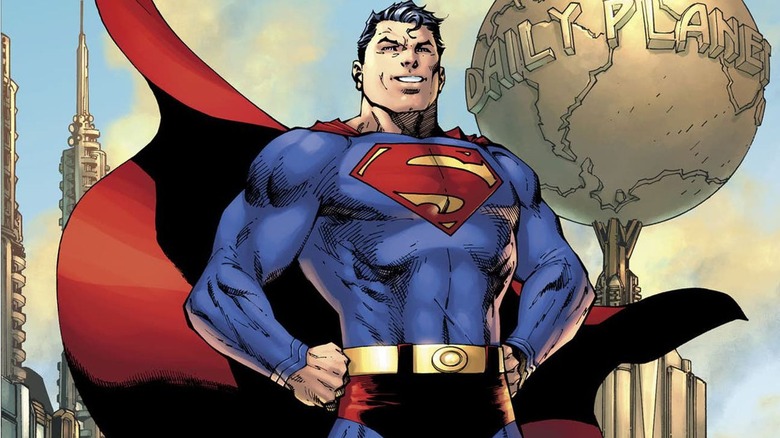The Greatest Superman Story Of All Time Happened In The Real World
Few fictional characters mean as much to so many as Superman. While some dorks may call the nearly invincible superhero "boring" because of his vast array of abilities and Boy Scout attitude, that's missing the point. Profoundly. Superman is an incredible character not because he's faster than a speeding bullet and more powerful than a locomotive but because he has infinite power and makes the choice to use his powers to help the downtrodden and uplift the world around him. When given the powers of a god, Clark Kent doesn't seek self-aggrandizement or pursue selfish ends — he works to make the world a better place. Selflessly. He's the beacon for what we, what humanity, can strive for.
And in 1946, Superman, champion of justice and righteousness, battled the Ku Klux Klan.
In the radio drama series "The Adventures of Superman," the Man of Steel went up against an organization known as The Clan of the Fiery Cross, clearly modeled on the real-life hate group. And while this is a famous and oft-told story, it's one that bears repeating, especially in a time period as tumultuous and terrifying as ours. A new video from the folks at Grunge details the story behind this historical moment and how it all came together. And perhaps most importantly, why we should never forget it.
The story of Stetson Kennedy
In the 1940s, the Klan was still very much alive, though membership had dwindled from its early days. But the bigoted organization was on the verge of resurging, and that was something that understandably did not sit well with Stetson Kennedy, a human rights activist and writer who worried that the Klan had too many connections to people in power.
Kennedy hatched a plan: he would infiltrate the Klan to learn their secrets and help bring their shadowy rituals out into the light. Kennedy gathered a wealth of information and in the process, began to realize that for all their violence and hate, the Klan itself and its various rituals were inherently ridiculous. Kennedy reasoned that if the rest of the world saw how foolish the organization was it would help strike a blow against the KKK. He needed to get his findings out to a wide audience.
And that's where Superman, a very fictional character with a power and influence that cannot be contained by a comic book or radio show or television program, comes in.
Superman smashes the Klan
Superman took to the radio airwaves in 1940 with the radio serial "The Adventures of Superman," which ran from 1940 to 1951 and aired 2,088 episodes. By 1946, the writers of "The Adventures of Superman" were looking for more villains for the Man of Steel to battle. Enter Stetson Kennedy, who pitched the show on the idea of Superman fighting the Klan.
The result was "Clan of the Fiery Cross," a 16-part story in which Superman goes up against a racist organization based on the Klan, who have targeted a Chinese-American family. The episodes detail the Klan's secrets and trivialize them, and this did not sit well with real-life KKK members. Leaders tried to stage a boycott against the show's sponsor, Kellogg's. But the episodes were a big hit, and the boycott had no effect.
The Man of Steel triumphed over the KKK, and his fictional adventure had real-world results. According to Kennedy, new membership in the Klan dropped as the radio drama was airing, suggesting the show played a significant part in the downfall of the organization. In his book "Superman versus the Ku Klux Klan," Richard Bowers wrote: "'The Clan of the Fiery Cross' showed children — and adults — all over the country the deep-seated prejudice that fueled the KKK's mission and the greed for money that motivated its leaders. And the show's use of satire and ridicule set the stage for others to use those weapons against the Klan."
While "The Adventures of Superman" radio show might be a thing of the past, the "Clan of the Fiery Cross" story would inspire the three-part graphic novel "Superman Smashes the Klan," written by Gene Luen Yang with art by Gurihiru.
The man of tomorrow
While the KKK has not been fully eradicated (those loathsome white hoods have a habit of rearing their ugly heads in the right corners of the United States to this day), those who support their ideals have gotten craftier. More chameleonic. Marches and cross-burnings have become podcasts and YouTube channels. Extremism has seeped so thoroughly into the margins of modern culture that we've grown numb to it — the worst news hits our dead eyes and we just ... shrug. What are we supposed to do about it? What can we do about it?
The story of Stetson Kennedy should be a rallying cry in 2024. Here's a guy who actually did something about it, and he did it in his wheelhouse. Not everyone can run for public office and change things from the top. Not everyone can be an investigative reporter who sheds light on the darkest truths. But we can use what we are good at, what we're passionate about, to shift the world ever-so-slightly. In Kennedy's case, he helped create a great Superman story that used a beloved character as his avatar in the battle against evil. Individually, we can all nudge the needle, and great art, whether it be fine or pop, is part of the process.
I'm thinking about Superman today. And I'm thinking about Stetson Kennedy. And I'm thinking about the headlines that make me feel numb and powerless. And I think about Superman, the opposite of numb and powerless, and how he inspires me to be better. And because Superman is a work of fiction, I'm inspired by the work of creators who are, like me, only human. Nudge the needle.


